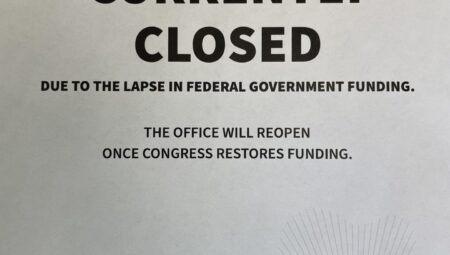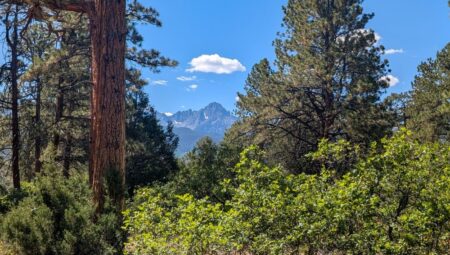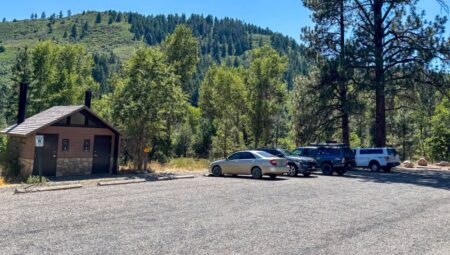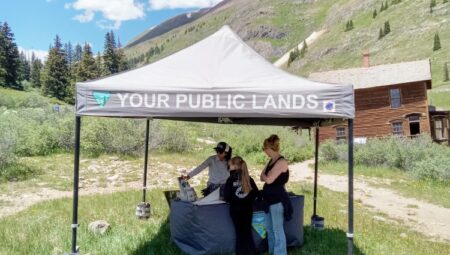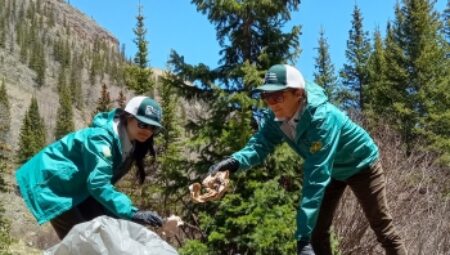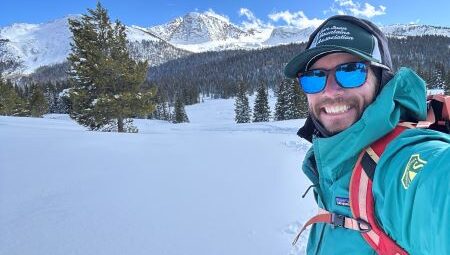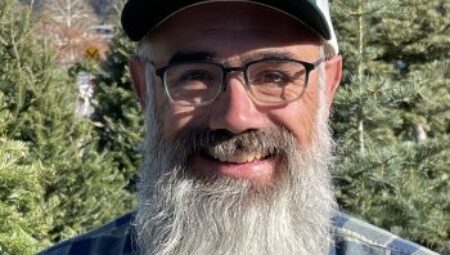What to Expect on Public Lands During the Shutdown
“The report of my death was an exaggeration,” is a well-known – and often mis-quoted – remark by Mark Twain. Recently, the San Juan Mountains Association was the subject of a similar misunderstanding. While corrected, it brought to light the need to explain how the government shutdown impacts public lands across the country, and particularly, our corner of it.
Anyone working for the federal government – or as its partner – knows that no two shutdowns are alike. This particular shutdown has even the most tenured federal employees scratching their heads. Land managers have been given a fair amount of discretion on how to implement closures. If you are traveling, and you are on federal lands, you will likely encounter a variety of scenarios. In some locations, everything may appear open and normal. Other areas may be completely closed, and in some places, you might find a mix of amenities closed – or open. For instance, a campground may be open, but the water or even the vault toilets are shut off and locked.
The reasons why certain locations may be open and others closed really has to do with the type of funding land managers have available to them. For instance, in Utah, the state tourism office foots the bill – at least for a little while – to keep the state’s five national parks open because it recognizes the significant economic impact tourists visiting those national parks provide to the state. Other locations may be digging into discretionary funds they receive from non-government sources such as campground fees to keep amenities open for a while.
As a government contractor, SJMA currently operates the retail outlets at public land offices throughout the San Juan Mountains, and we currently staff front desks for the San Juan National Forest Supervisors Office and two district offices, the BLM Gunnison Field Office, and the Canyon of the Ancients National Monument Visitor Center. With those offices closed, our Visitor Information Services (VIS) staff cannot work. If they aren’t working, SJMA cannot bill the federal government for those services, so those employees have been temporarily laid off. The shutdown affects six of SJMA’s 22 current employees. They are eligible and have been encouraged to apply for unemployment while the shutdown continues. As soon as the government reopens, they will hopefully return to their positions.
This challenge is not unique to SJMA. Most, if not all, visitor centers at national parks and federal public land agencies, like the US Forest Service, the Bureau of Land Management, and the US Fish & Wildlife Service across the United States, contract with non-profit organizations to operate visitor centers and gift stores. It’s economically efficient, and nonprofits prove more nimble than our government partners.
Where SJMA differs from many of our nonprofit colleagues across the country is that we do more than visitor information services. As an education and outreach organization, visitor information services is just one of SJMA’s three main pillars.
Stewardship is a second pillar, and is supported by a mix of some federal funds as well as support from many donors and sponsors. Fortunately, we wrapped up the busy season with most of our stewardship crews and volunteer stewardship opportunities in September, so this department has largely been unaffected.
Conservation Education is our third pillar, and aside from having to adjust for some closures, it is unaffected by the federal shutdown, and in fact, the education team has an array of programs operating across the entire San Juan region.
In this time of uncertainty, we encourage you to be a “Steward of the Land.” If you plan to visit public lands, be prepared for anything. You will likely encounter closures, especially if the shutdown drags on, which could mean loss of access to vault toilets, trash receptacles, potable water, and other amenities. Please be prepared to pack out all your waste and trash, avoid biking on muddy trails, and have enough supplies to care for yourself or others in the event of an emergency. While SJMA is still operating, our normal channels of communication are not. You can reach us at info@sjma.org with any questions.
Stephanie Weber is SJMA’s Executive Director.
- Published in Stewardship, Uncategorized
Sit spot in the ponderosa
By John Malloy
It was mid-day at 8,500 feet amid the Ponderosa and Oak scrub of Top of the Pines (TOP) Preserve outside Ridgway. The grasses, dried and aromatic, reminded me of chaparral. Luckily, I had been sitting contently in the shade for a good length of time. I couldn’t tell you how long. At the beginning of my weekend my watch was packed away; along with all my other electronics.
My goal was to sit, listen, look and feel what was going on in my surroundings. Take deep breaths and identify faint smells, listen to the varied sounds of the wind and slight noises from traveling insects. As I sat, I made detailed observations of small areas of the forest floor, and then recalled them from memory. Needles, moss, ants, spent pollen cones and decaying cone scales made a mosaic at my feet.
My trance was broken by the fascinating swoosh of a bird’s wing cutting through the air. I was close enough to hear the ripple of each flight feather on its outstretched wing. The flash of white and gray hinted of a Clarks Nutcracker, Nucifraga columbiana. This is a unique, but popular bird. Its alias, Camp Robber, is used by many. Discovered by William Clark, of the Lewis and Clark expedition, it earned a place on the list of “new” North American species in the early 1800s.
Of course, the birds have been roaming the west for millenia. Known by Native Americans for centuries. The bird is a master of memory and dexterity. It feeds on seeds of various pine species and rather than gorge itself, creates a cache of up to 10,000 seeds throughout the landscape. When winter comes they return to each cache and feed on the nuts and seeds, so long as the resident chipmunks and ground squirrels have not yet made off with their larder. The caches that are not found sometimes propagate into new trees, so the bird has a mutualistic relationship with the tree species it depends on. The trees provide food, and the bird promotes seed dispersal for the tree.
This is but one of many intriguing relationships we observe while at Top of the Pines (TOP) near Ridgway, and it is just the beginning of our familiarization with this new landscape. SJMA has formed a partnership with the group managing TOP and has plans to develop a number of unique and engaging programs at the site.
Currently we are practicing the Naturalist Awareness program. Soon though, small groups of school-age youths will be invited to participate in lessons focused on Backcountry skills, Land Stewardship, and Natural History. What makes this opportunity unique are two things. First, the Board of TOP and a generous donor, have agreed to pay for our K-12 students to attend these programs. Second, the programs are specifically focused on students’ immersion into the landscape, where they are encouraged to explore and inquire, and are given the knowledge to do so confidently and responsibly.
If you are interested in being involved with SJMA at Top of the Pines, or any of our other programs please contact info@sjma.org. Or call 385-1210
John Malloy is SJMA’s North Region Program Coordinator.
- Published in Education, Stewardship, Trees
The power of collaboration
By Andy Hawk
The verb collaborate is “to work jointly with others or together especially in an intellectual endeavor.” Collaboration, the noun, might need a subdefinition of; messy, slow, argumentative, and occasionally illogical, but in the end, enormously rewarding. In 2019, our community embarked on a journey of collaboration, with the goal of improving forest health, supporting wildlife resources, protecting watersheds, returning healthy fire to our landscape and executing projects that knit together the array of jurisdictions and land ownerships common to our region. Stakeholders, representing numerous local and regional nonprofits, local government bodies, federal and state agencies, and regional businesses, sat down at the table to create what would become the Southwest Colorado Collaborative Forest Landscape Restoration Program. SJMA has had a seat at this community table from day-one, and we continue to represent our key values of Explore, Learn, Protect in these collaborative conversations today.
Fast forwarding nearly six years, through pandemic, drought and abundance, agreement and litigation, some of what was originally conceived in those early conversations can now be seen taking shape in our region. With funding provided to the San Juan National Forest, via the USDA CFLRP, projects such as the recently completed Junction Creek road chip-seal, the ongoing Grassy Mountain Shared Stewardship project, and the soon to begin Durango Hills fuels reduction project are the culmination of collaborative work and community voices. The fate of the USDA CFLRP is uncertain, but our community did well by engaging early and sticking to the vision that collaboration, as fractious and nonlinear as it can be, is what makes our natural world better.
Why on earth would funding for forest health be used for road work? This question resulted in some robust, not always agreeable conversations among CFLPR stakeholders. The answer is tied to other community planning efforts, the Junction, Falls Creek Integrated Management Plan Environmental Assessment and the Durango Northwest Recreation Environmental Assessment specifically. As odd as it may seem, the work to pave and improve the parking area at the Colorado Trail trailhead and to chip-seal the first few miles of the Junction Creek road, on the San Juan National Forest, are tied to goals of the SW CO CFLRP. To be able to conduct work at the human powered scale, and at the scale of logging equipment requires access. Additionally, the Junction Creek corridor is a priority fireshed for Durango and outlying subdivisions. With the rehabilitation of the road, the greater watershed is now primed for access, allowing for stream bank rehabilitation along the water course, hand thinning of small fuels on steep slopes and sensitive areas, mechanical thinning and mastication on other areas, and even activities such as small-scale commercial timber harvest.
How does SJMA fit into the pile of spaghetti that is collaboration? Well, we are often the translator of acronyms, the conveyor of facts at the Visitor Information Services desk, and the encouraging voice of the educator on a field trip for eager outside learners. Our Forest Ambassadors, with support from Care for Durango, were at the Colorado Trailhead this summer educating users about the chip-seal project, asking for patience during delays on the road and conveying the message that it takes years to plan, fund and execute the work but when finished, these projects open the door to many more opportunities. While we do not know the future of some of the local collaborative efforts, we do know we can share in the successes of the last six years of efforts put in by stakeholders, from a wide range of community sectors. While you are out and about enjoying the treasure that is our home region this summer and fall, take a moment to consider just how many public hands have played a role in what you see on public lands.
Andy Hawk is SJMA’s Associate Director.
- Published in Education, News, Stewardship, Uncategorized
Stewardship helps promote healthy ecosystems
We are coming out of a rainy spring in the San Juans. The monsoons are already here, and with them, the strong winds carry aromas, revolve the leaves and also increase our curiosity to explore and enjoy the summer. Some of us can even smell the mushroom spores in the air as the wind blows. With all this rain, the fungi are also coming early to serve their role in the forest, just as the ambassadors of the San Juan Mountains Association are working across National Forest and Bureau of Land Management lands to accomplish our purpose as stewards of the land.
Fungi play an essential role in maintaining healthy ecosystems by utilizing their remarkable abilities. They assist plants in increasing their water and nutrient intake, secure the diversity of a biome and even provide a food source for a variety of species, from microorganisms and insects to mammals, including humans. As we all explore the trails of the beautiful San Juan Mountains, fungi quietly work to maintain the well-being of their habitat.
As SJMA ambassadors, we are also working to protect and stabilize our environments. We work alongside our federal agency partners to balance out the relationship between people and the wilderness; between outdoor recreationists and our public lands. We strive to meet the diverse needs of the environment and do our best to maintain the harmony of all natural and recreational resources. We strive to keep your favorite trails clear and remove fallen trees and trim bushes, so you can go on that hike and absorb the nutrients of nature. We will ask you to stay on the trail in exchange, and pack out what you packed in, because all of us have a role in keeping a healthy ecosystem. When we enter the wilderness, there is an exchange. The call to reciprocity summons us all.
The fungi take good care of the network of living things, also because they need it to subsist and sustain themselves. People need nature. We venture into the wilderness seeking that singular nourishing experience, and nature generously grants it to us each time. As we give back active care and respect, we will have learned what these mushroom spores blowing in the air came to remind us. We all depend on each other.
As stewards of the land, the call is to minimize our impact and spread awareness of our reciprocal and dependent relationship with the land. As you follow Leave-No-Trace principles and make an effort to leave what you find and dispose of your waste properly, SJMA forest and Alpine Loop ambassadors carefully retrieve pieces of microplastics, glass, cans and more from the ground to help the soil restore itself. In the meantime, decomposer fungi recycle wood, converting them into carbon, minerals and nutrients that will nourish and replenish the same soil. That healthful soil will grow the trees, flowers and grasses that you love to observe while exploring your favorite trail.
SJMA’s role as stewards is rooted in this cycle of life, as we nourish one another. When you see us on the trails of the San Juan Mountains or the tundra landscapes of the Alpine Loop byway, come talk to us. We love hearing from you, your experiences in the outdoors and your insights, as well as sharing our best knowledge of recreating responsibly. Let’s continue to foster reciprocal connections within this ecosystem. Let’s cherish our precious public lands and one another.
Adela Pizarro-Conte serves as an Alpine Loop ambassador for the San Juan Mountains Association and is passionate about connecting people with the wonders of the natural world.
- Published in Stewardship
If Not You, Then Who?
By Meg Burke
Memorial Day has come and gone, and the San Juan Mountains Association (SJMA) field crews are out in full force. The unofficial start of summer is upon us, and we have already seen an uptick in visitors to our public lands. As our federal land managers scramble to salvage what’s left of their reduced budgets and crews, SJMA has ratcheted up our efforts to support our partners and public lands.
Working with the San Juan National Forest, Visit Durango, San Juan County, and our own donors, SJMA has secured funding to ensure the 14 bathrooms across the San Juan National Forest’s Columbine District will be open for the season. We are also working to secure ongoing funding for porta potties at Ice Lake Trailhead. Providing this much-needed resource to such a heavily visited area is vital to helping keep the forest clean and our watersheds healthy.
In addition to helping our public lands with “waste management”, SJMA has also increased efforts to help improve trail access. We have two SJMA Forest Ambassadors who have obtained cross cut saw certifications. With this skill, they can add to the efforts of our four-person Wilderness Crew, in collaboration with San Juan National Forest personnel, to clear trails and improve access into the Weminuche. During their first hitch out, SJMA’s Wilderness Crew cleared 82 downed trees from approximately four miles of the Lake Fork trail (from Pine River trail to Emerald Lake) – amazing!
While the Wilderness Crew is in the backcountry, the Forest Ambassadors work at the busiest trailheads and along the Alpine Loop, educating visitors on recreating responsibly while enjoying our forest and BLM lands, sharing essential messages on topics such as wildfire and campfire safety and caring for these destinations so everyone can continue to enjoy them. As they roam, it is a great asset to have the extra boots and eyes on the ground to complement the reduced boots-on-the-ground capabilities of our federal partners.
We all have a role to play in caring for and protecting our public lands. It is time to step out of the “somebody else will do it” mindset and support our public lands and the organizations that work so diligently to protect them. It will take everyone to contribute what they can, whether that takes the form of volunteering, making monetary donations, or becoming a member to support conservation organizations in your area. Through these turbulent times, please take a moment to remember what first ignited your passion for our wide-open spaces, and that we want to preserve that experience for generations to come.
Meg Burke is the SJMA Stewardship Director and lives in Mancos with her husband, and their many dogs and chickens.
- Published in Stewardship
The magic is always there
By Colin Courtney
Winter seems to come and go in lower elevation communities like Durango and Cortez, but our snowpack (although low for the year) at Andrews Lake Winter Recreation Area keeps sparkling with life, offering many gifts to those who come to wander among its beauty. It really is a magical place up there, and San Juan Mountains Association is dedicated to helping people connect to the land, learn how to protect it and become stewards themselves. It is more important than ever that we the people work diligently to educate, protect and care for these special places.
From hot cocoa barista-ing to helping fit snowshoes for the first time, SJMA’s snow ambassadors take great joy in helping people recreate responsibly and enjoy their time among the magic. When people have a great time out in nature they are more likely to want to help take care of it, and protect it for generations upon generations. The societal world is a wild place right now, and the serenity, love and awe of Andrews Lake is still there just waiting for the next visitor to bestow its gifts on.
When we stop to catch our breath (physically and metaphorically), we are gifted with the opportunity to become aware of the magic. It is always there, always giving to us and lights up with joy when we take that moment to intentionally become aware. The Japanese prescribe these experiences in their hospitals. It’s called Shinrin-Yoku, Forest Bathing. In their cities, they have designated nature areas and walking paths for people to go sit in nature, breathe, put their phones on silent and just be. We are so lucky to be surrounded by these places here, but we must be intentional to go be with them and help protect them. The nurturance that comes from nature flows like an infinite source, and all it requires to keep this flow happening is a little love and respect. Practicing simple Leave-No-Trace principles goes a long way, and a bit of education is paramount to keeping the flow going.
Just the other day a visitor came to Andrews Lake with a pack of dogs in the back of his truck. Our snow ambassador went over to see if he needed any doggy poop bags to pack out their droppings. The man seemed to have recently inherited these dogs and honestly admitted he didn’t know why he needed to pack it out. Education with love in the heart is the name of the game. Our snow ambassador thanked him for his honesty and went on to explain how E. coli is often present in dog droppings, and when left on the surface to break down, the E. coli works its way into streams, rivers and lakes, contaminating our local water systems. The man was taken aback by this knowledge and quickly asked for some bags and said he would absolutely be packing all of it out from the forest from now on. The interaction was positive, respectful and educational. This is stewardship. It is a beautiful thing when education comes from the heart, it sticks, and there is no reason to repel it.
Make some time to come practice Shinrin-Yoku at Andrews Lake, join us for one of the last couple of Snow Science & Social tours, educate yourself and others about the simple seven Leave-No-Trace principles to help keep our wild places beautiful forever; and remember the magic is always there.
Colin Courtney works as the snow ambassador at Andrews Lake Winter Recreation Area for SJMA and is passionate about protecting our natural places and spreading the joy of playing outside.
- Published in Stewardship, Winter
Wildfire Preparedness and Mitigation Succeeds Through a Collaborative Approach
By Andy Hawk
As we have all recently witnessed, it is never too soon to discuss wildfire preparedness and mitigation. Whether it is through one of the regional forest collaboratives, a home ignition zone evaluation, or a planning meeting with an HOA, living in one of the Nations’ Priority Firesheds takes a collaborative approach. Although it is only February, please be certain the extensive networks of governmental officials, scientists, citizens, educators, and fire professionals are already executing plans which have been developed via community processes over many years.
Local government staff, US Forest Service and Bureau of Land Management fire professionals, fire mitigation contractors, consulting foresters, wildlife scientists, and education organizations such as San Juan Mountains Association (SJMA) gather around a collaborative table monthly discussing and planning for the inevitable threat our communities, ranchers, and land managers face when a fire has grown beyond healthy and beneficial for the landscape into something catastrophic.
One of SJMA’s three key tenets is “Learn.” We must learn from subject matter experts and experienced professionals before we can then, in turn, educate others. Southwest Colorado is fortunate to have well-established groups of diverse stakeholders such as the 4-Rivers Resilient
Forest Collaborative, known locally as “4-Rivers,” in La Plata and San Juan counties as well as the Dolores Watershed Collaborative in Montezuma County to provide such a valuable information sharing and learning environment.
SJMA’s role at these community tables is to both learn and to educate, which is a very welcome role indeed. We take project scoping documents from National Forest planning endeavors to our teams of dedicated staff and volunteers, helping them understand what is happening across the region. Our education team takes the evolving realm of fire ecology and fire adaptation into the outdoor classrooms and experiential labs in which regional kids thrive. We amplify the voices of organizations such as Mountain Studies Institute, Wildfire Adapted Partnership, the Wildfire and Watershed Protection Fund, Durango Fire Protection District, the La Plata County Wildfire Information Center, and many others so our community has access to as much information as possible. Our network of volunteers and Forest Ambassadors can then take these learnings to the growing numbers of visitors who are here to escape the heat of home, bag a peak on the
list, spend an unforgettable afternoon sitting in solitude while absorbing the expanse of a flower filled meadow or connecting a young child to our precious outdoor resources.
This late winter and early spring, in a year when current snow water equivalents are not promising, I encourage you to take advantage of the fire planning, fire mitigation, fire preparedness, and forest health resources which have been developed by our community over a decade or more. Fire is in the bones and bedrock of our region, it is our job to be educated and prepared.
Andy Hawk is the Associate Director of SJMA, he takes delight in sharing stories of a life lived thus far up and down the spine of the country.
- Published in Education, Stewardship
San Juan Mountains Association’s Annual FUNdraiser, Christmas Trees for Conservation
By Nick McKey
I got the first text from a friend to go skiing on October 21st this year. Safe to say with this early cold snap, we’re all looking forward to the winter rituals after a hot summer. I’ll say, I’m a summer guy myself, I’d rather be on my bike, in a t-shirt, with the light not leaving until 9pm or later. But, with holidays on the horizon, and it invokes now-happy memories of my dad making me stand in the street making sure the wreaths on the front porch pillars at my childhood home back in Michigan were level.
The rituals I’ve been dropped into here at the San Juan Mountains Association (SJMA) office are a little less Christmas Story. When I interviewed for my position in late June, I was told that I would be immersed in the holiday spirit starting in September with our “Christmas Trees for Conservation” fundraiser. This is SJMA’s only fundraising event, and it provides critical support for all of our stewardship and education programs. I’m so thankful for my old man helping me love the holidays. Every time we’ve driven out to Beaver Meadows, the location of our tree harvest, I have to remind myself that it’s not normal to want to play Christmas music in September.
Out in Beaver Meadows, a sleepy little spot northeast of Bayfield, we’ve been busy counting, measuring, and marking White Firs to stock our Christmas Tree Lot down at the D&SNGRR lot. These White Firs, whilst a staple of an idyllic pine forest, are the perfect ladder fuel. Unlike their larger, more fire-adapted cousin, the ponderosa, they don’t drop their lower branches, their sap is an incredibly efficient fire starter, and the juvenile pines are super adept at crowding around other trees. This makes the white fir a terrifying multiplier for any fire that would come through the forest. SJMA’s fundraiser has the added benefit of improving forest health, albeit in a small, but meaningful way.
Our goal is to take 450 of these white firs from the forest and put them in homes for the holidays. The humble white fir doesn’t drop its needles for quite some time after being cut, usually they’re fairly symmetrical, and we get them cut at the right height to fit just right for Durango homes. But obviously, cutting, hauling, moving, netting, and selling 450 Christmas trees is too big of a task for SJMA’s permanent staff, and that’s where we ask the community to give us a hand! There’s a task, cookies, and hot drinks for everyone who wants to pitch in and help, whether you want to sell trees or get a peek into what fuel mitigation looks like!
We’re looking for all the help we can get on our cut day, which is Saturday, November 23rd at Beaver Meadows. Having worked in conservation for the last 4ish years, I can tell you that the more hands we’ve got, the more efficient we can be. Our biggest bottleneck is getting trailers to get them down from Beaver Meadows to our lot at the D&SNGRR, so if you’ve got a trailer you don’t mind potentially getting a little muddy, please consider signing up! If you’re not interested in driving trailers, we’ve also got a massive need for volunteers to help move and net the trees up at Beaver Meadows and to help set up the lot in town. If you’ve got the time and can switch from Thanksgiving spirit to Christmas and back on that Saturday, we’d love to have you join us.
Once the trees are down in the lot, we sell them from the 29th of November until they’re all sold, so if removing trees from the mountains isn’t your speed, we invite you to join us at the tree lot. There’s a job suitable for all skill levels every day starting on the 29th. Located downtown, in the middle of the holidays, it’s an engaging time slinging trees to folks. Looking through the pictures from past tree lots, I have seen so many pictures of old friends, so even though it’s my first Christmas Tree lot with SJMA, I know it’s going to be a hoot of a time with new and old friends celebrating the holidays, supporting SJMA, and helping our public lands.
Nick McKey, SJMA’s Volunteer Coordinator
- Published in Stewardship
Stewarding the Alpine Loop: Protecting the Heart of Colorado’s High-Alpine Wilderness
By Aubrey Balcom
The Alpine Loop, a rugged byway winding through Colorado’s San Juan Mountains, is renowned for its stunning vistas, rugged terrain, and remote beauty. But behind its breathtaking landscapes is a region rich with history and fragile ecosystems that require careful stewardship. As an Alpine Loop Ambassador for the San Juan Mountains Association (SJMA) based in Silverton, Colorado, I learned that while these lands attract adventure-seekers, they also require a deep commitment to their protection.
Dating back to the 1870s, the Alpine Loop has long been shaped by Colorado’s mining boom. Today, remnants of this mining legacy—ghost towns, abandoned mine shafts, and machinery—serve as physical reminders of the area’s past. However, these historical features also bring modern challenges. The lingering effects of mining activities, such as erosion, contamination, and habitat disruption, make conservation efforts all the more critical. While history is important, balancing these legacies with ecological health requires careful management.
Beyond its historical significance, the Alpine Loop is home to some of Colorado’s most rare and delicate ecosystems, such as high-altitude wetland fens. These wetlands, often found at elevations above 10,000 feet, are incredibly rare but crucial to the region’s ecological health. Acting as natural water filters, fens trap pollutants and regulate water flow, which helps maintain the integrity of the surrounding environment. They also support unique plant and animal species that rely on their delicate balance. Protecting these ecosystems from disturbances is critical, as even small impacts can have significant consequences.
In addition to these rare ecosystems, the Alpine Loop hosts a variety of iconic wildlife. Beaver, for example, play a key role in shaping the landscape through their dam-building activities, which provide vital habitat for other species. Moose, once nearly extirpated in Colorado, have made a strong comeback in the area and are often spotted grazing in the meadows. Other wildlife includes yellow-bellied marmots, pikas that dart among the rocks, and a wide range of bird species that thrive in these high-alpine environments.
While monitoring these ecosystems, I was also fortunate to witness an extremely rare sight—a badger meandering over to its den at nearly 12,000 feet. This unexpected encounter reminded me just how resilient and interconnected these ecosystems are. The Alpine Loop’s wildlife, from the smallest pika to the rare badger, all depend on healthy, undisturbed habitats.
As an ambassador, my role was to educate visitors about their impact on this unique wilderness. Whether stationed at trailheads or driving the rugged Alpine Loop roads, I spoke with hikers, OHV riders, and campers about minimizing their impact on the land. Staying on designated trails, respecting wildlife habitats, and practicing Leave-No-Trace principles were essential to ensuring that these rare ecosystems remained intact for future generations.
In addition to education, I also monitored the health of the Alpine Loop by tracking visitor numbers, noting trail wear, and observing changes in the wetlands and tundra. By documenting these conditions and reporting them to BLM officials, I contributed to conservation efforts aimed at preserving the loop’s beauty and ecological integrity for future generations.
The stewardship of the Alpine Loop is a collective responsibility. From its mining history to its rare ecosystems and diverse wildlife, protecting this land is essential to preserving its beauty and ecological health. Through education, awareness, and responsible recreation, we can ensure that the Alpine Loop remains a wild, pristine wilderness for years to come.
Aubrey Balcom served as the Alpine Loop Ambassador for the San Juan Mountains Association, she is an environmental educator and Master of Environmental Management student at Western Colorado University, with a passion for wildlife photography and mountain exploration. You can find some of her photography work on Instagram: @aubrey_outside
- Published in Stewardship
Securing San Juan stewards
By Thomas Fritz
With school back in action, and students returning to classrooms for the fall semester, SJMA will be joining right alongside them. Education staff look forward to teaching local students about the wonder of the place they call home and helping them spend quality time in it. Throughout fall, students in the San Juan Mountains region will receive place-based experiential education to better understand the world around them. Students who participate in SJMA’s educational programs are proven to develop a strong sense of stewardship – not only toward general ecological systems, but also toward the mountains they call home. SJMA’s mission is to work with the new generation of stewards to inspire and promote a sense of responsibility in caring for the land.
Over the course of the fall semester:
- SJMA will guide students through lessons on geologic processes to understand how the mountains have formed and are actively changing. Field trips to local sites that provide a close-up view of these processes are an exciting way to learn experientially by interacting firsthand with the landscape.
- Students have the opportunity to engage with the regional biodiversity through lessons on life cycles, plant and animal adaptations as well as biomes based on elevation.
- As winter approaches, students will understand how different organisms prepare for the cold weather and how watersheds transition into “snow sheds” – and if that has an effect on the lives of residents of the area.
Playing the long game of securing San Juan stewards has paid out (and continues to) when reflecting on the impact SJMA programs have had on students. The investment in educating these students transfers to their families when they recreate on the landscape. As the students learn and grow, they inevitably teach others about why we should care for the land.
At SJMA we get to watch “local kids” who participated in summer camps and school programs get out and earn degrees that assist them in giving back to the San Juans. Teal Lehto, one of these examples, was a student who participated in Durango Nature Studies programs in her youth prior to the merger with San Juan Mountains Association in 2020. Teal credits her early engagement with DNS as part of the inspiration for her degree in Environmental Studies. Now an activist for water rights and founder of Western Water Girl, Teal continues to work closely with SJMA to promote stewardship over the region through her time as a Forest Ambassador and now Social Media Manager. This is one example that not only are SJMA’s educational programs fun and engaging, they also have a lasting effect on those that participate to help better the world around us.
Securing future stewards to continue this effort for years to come does have its challenges. Without partnerships SJMA would have a difficult time delivering the effective lessons we are so lucky to share. San Juan National Forest, local landowners, farmers, and partner organizations are a crucial part of the education local youth receive. SJMA has established a relationship of trust in the surrounding area that students’ education will be at the forefront when it comes to planning field trips, visiting local farms, touring conserved properties and understanding how humans play a role in the ever-changing landscape. This is not to say that effective experiences require families to have the same partnerships to be great stewards of the land. Part of SJMA’s mission is to communicate with locals and visitors alike, the beauty of our public lands. When students have the opportunity to learn from SJMA’s education team, they often find themselves in places they have never seen before even though they’ve lived in the area their whole lives. Exposure to new places, environments and ecological systems help broaden the idea of what “home” truly means to these students and that is the first step in not only understanding but also loving and caring for the special place we get to share in the San Juan Mountains.
Thomas Fritz is SJMA’s Education Specialist helping youth connect to the natural world.
- Published in Education, Stewardship

